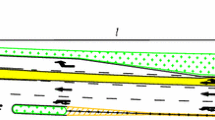Abstract
The innovative concept of intermittent bus lanes may lead to an important increase of bus system performance while limiting the reduction of the capacity devoted to general traffic. The main idea is that a general traffic lane can be intermittently converted to an exclusive bus lane. Frequently studied by analytical papers, practical demonstrations of the intermittent bus lane strategy are not numerous. Especially, the results of the two previous field tests are very specific to the test sites and are hardly transposable. This paper tries to fill this gap by proposing the results and the lessons learned of a new real-field demonstration in Lyon, France. After a detailed presentation of the 350-m case study, effects of an intermittent bus lane strategy on traffic conditions are evaluated. Then, analyses of the impacts on the bus systems performance are carefully performed and also compared to more classical bus operations: a transit signal priority strategy. The results show that an intermittent bus lane can be a promising strategy especially when it is combined with transit signal priority. The median travel time of the buses is significantly reduced whereas the regularity of the line increases.





Similar content being viewed by others
References
Bagherian M, Mesbah M, Ferreira L (2015) Using delay functions to evaluate transit priority at signals. Public Transp 7(1):61–75
Berrebi SJ, Hans E, Chiabaut N, Laval JA, Leclercq L, Watkins KE (2018) Comparing bus holding methods with and without real-time prediction. Transp Res Part C 87:197–211
Chiabaut N (2015) Investigating impacts of pickup-delivery maneuvers on traffic flow dynamics. Transp Res Proced 6:351–364
Chiabaut N, Xie X, Leclercq L (2012) Road capacity and travel times with bus lanes and intermittent priority activation: analytical investigations. Transp Res Rec 2315:182–190
Chiabaut N, Xie X, Leclercq L (2014) Performance analysis for different designs of a multimodal urban arterial. Transp B Transp Dyn 2(3):229–245
Currie G, Lai H (2008) Intermittent and dynamic transit lanes: Melbourne, Australia, experience. Transp Res Rec 2072:49–56
Eichler M (2006) Bus lanes with intermittent priority: assessment and design. Master’s thesis, Department of City and Regional Planning, University of California, Berkeley
Eichler M, Daganzo CF (2006) Bus lanes with intermittent priority: strategy formulae and an evaluation. Transp Res Part B Methodol 40(9):731–744
Guler S, Cassidy M (2012) Strategies for sharing bottleneck capacity among buses and cars. Transp Res Part B Methodol 46(10):1334–1345
Guler I, Menendez M (2015) Pre-signals for bus priority: basic guidelines for implementation. Public Transp 7(3):339–354
National Academies of Sciences, Engineering, and Medicine (2013) Transit capacity and quality of service manual, 3rd edn. The National Academies Press, Washington, DC
Thamizh Arasan V, Vedagiri P (2010) Study of the impact of exclusive bus lane under highly heterogeneous traffic condition. Public Transp 2:135–155
Todd M, Barth M, Eichler M, Daganzo C, Shaheen S (2006) Enhanced transit strategies: bus lanes with intermittent priority and ITS technology architectures for TOD enhancement. In: California PATH Research Report, UCB-ITS-PRR-2006-2
Viegas J, Lu B (1997) Turn of the century, survival of the compact city, revival of public transport. In: Meersman H, Van de Voorde E (eds) Transforming the port and transportation business. Studiecentrum voor Economisch en Sociaal Onderzoek, Antwerp, Belgium, pp 55–63
Viegas J, Lu B (2004) The intermittent bus lane signals setting within an area. Transp Res Part C Emerg Technol 12(6):453–469
Viegas J, Roque R, Lu B, Vieira J (2007) The intermittent bus lane system: demonstration in Lisbon. In: Proceedings of the 86th transportation research board annual meeting (TRB)
Wu J, Hounsell N (1998) Bus priority using pre-signals. Transp Res Part A 32(8):563–583
Acknowledgements
The authors are grateful to the Metropole de Lyon (Mr. Pierre Soulard and his team) for their energy to experiment such an innovative solution. We also thank them for all the support in the data collection. This project is partly supported by the European Research Council (ERC) under the European Union’s Horizon 2020 research and innovation program (grant agreement No. 646592 – MAGnUM project). An earlier version of this paper was presented at TRB: http://amonline.trb.org/18-00028-1.3991208?qr=1
Author information
Authors and Affiliations
Corresponding author
Additional information
Publisher's Note
Springer Nature remains neutral with regard to jurisdictional claims in published maps and institutional affiliations.
Rights and permissions
About this article
Cite this article
Chiabaut, N., Barcet, A. Demonstration and evaluation of an intermittent bus lane strategy. Public Transp 11, 443–456 (2019). https://doi.org/10.1007/s12469-019-00210-3
Accepted:
Published:
Issue Date:
DOI: https://doi.org/10.1007/s12469-019-00210-3




